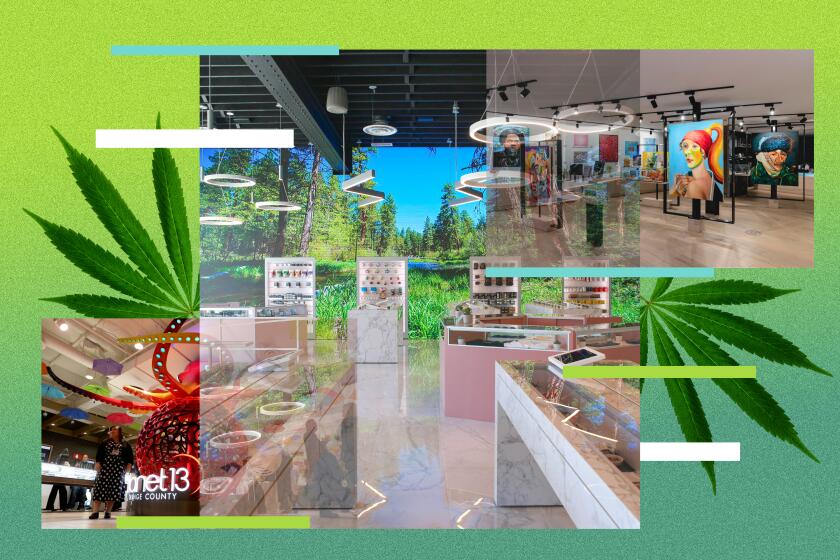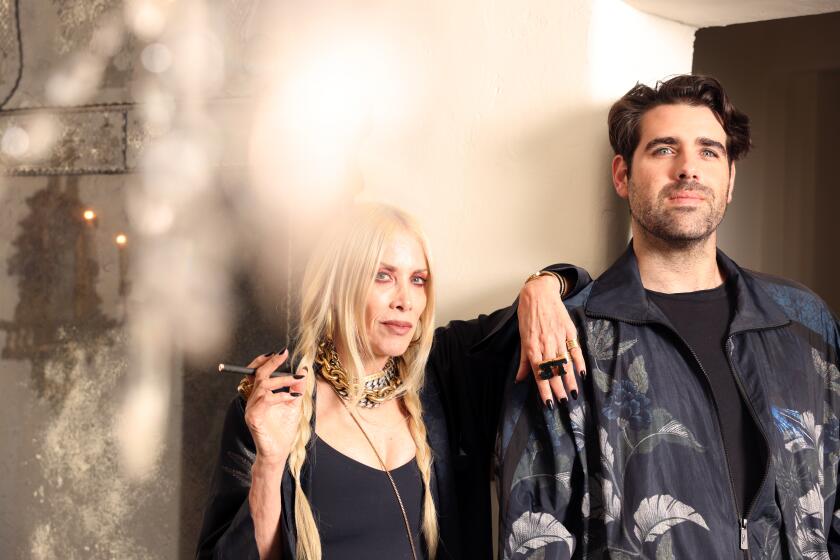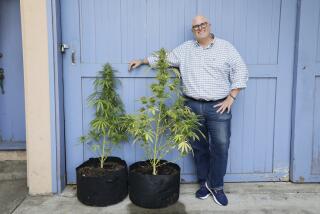Growing my first pot plant was easy — until it was time to smoke it
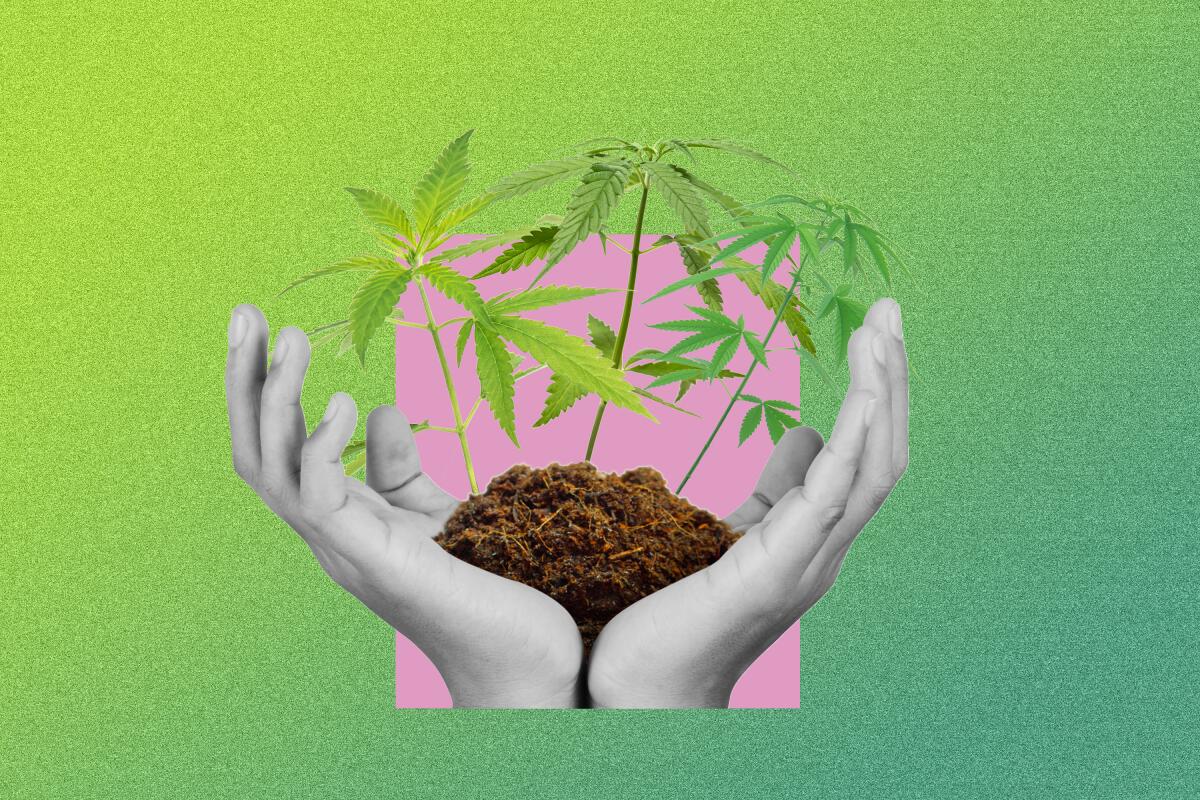
- Share via
For almost as long as I’ve known about the cannabis plant, I’ve wanted to grow my own weed. This is partly because I like everything about it; not just the psychoactive effect of combusting and inhaling it, but also the way it looks, from the slender serrated fan leaves to the densely packed flowers shimmering with a crystal-like dusting (called trichomes, these tiny, hair-like structures are home to the high-producing compound THC). I like the skunky smell of a live plant, and I appreciate the fact that it’s only the female of the genus that will get you high.
But the desire to get my grow on also has a lot to do with how I grew up in rural Vermont.
When I was a kid, my family had a small farm (so small that it hardly qualified as a farm by Vermont standards) that started with a cow and grew to include a pig, chickens and a flock of sheep that grazed the field beyond our vegetable garden. Only the milk cow, Star, who had come into our family as my brother’s 4-H project, was ever named. We’d been taught from an early age that the rest of the hoofed and clawed creatures around us were livestock (as opposed to pets) and cautioned against forming an emotional bond.
In addition to having a hand in bringing eggs, bacon, chicken and milk to the table, my siblings and I saw how wool becomes yarn. We learned how to make rhubarb wine (the first kid down the stairs in the morning usually gave the crock full of fermenting fruit a good stir), how to bake bread on a wood stove (the Dutch oven came in clutch) and how to turn the sap from the trees around us into maple syrup. In short, we were doing farm-to-table before farm-to-table was even a thing, and it gave me a keen appreciation of the effort that goes into things that I otherwise would have taken for granted.
That’s why, when faced with midpandemic boredom, in a state where it’s legal to grow (under California law, anyone 21 and older can grow up to six plants for recreational use) and with an unused everything-but-the-seeds kit from A Pot for Pot (purchased while researching The Times’ 2020 holiday cannabis gift guide) lurking in the corner of my home office, I decided to connect with my roots by trying to get a pot plant to put down the same. By following the process from start to finish, I reasoned, I’d be able to better appreciate how those dried little nuggets of instant staycation get from the soil to the dispensary shelf.
From art galleries and speakeasies to deli themes and circus vibes, dispensaries have gone next-level.
That wasn’t the only connection I was hoping for. I saw becoming an L.A. pot-plant parent as a way to gain entree to an invisible social network in this city in the way those who raise children here end up forming lifelong bonds with strangers who happen to have had kids at the same time. Instead of bonding over hastily arranged carpool schedules or sitting on the sidelines at a soccer game together, I imagined mingling with first-time marijuana moms and dope dads in the gardening supply aisle at Lowe’s, sharing baby pictures of our leafy green chlorophyll kids and trading curing tips and yield-boosting hacks.
I knew these folks would be out there, somewhere, just as I was, hopping on the quarantine gardening train for some of the same reasons — and no doubt some different ones. Some would be planting their own pot to do an end run around corporate cannabis (which, with each passing day, looks more and more like Big Pharma and Big Tobacco). Others would pursue pot parenthood to save money (buying weed in L.A. — legally — includes taxes that increase the cost of THC-containing products by more than a third) or to stick a green thumb squarely in the eye of Johnny Law as a kind of cosmically satisfying payback for decades of cannabis prohibition. (Growing your own is legal in the Golden State, but it remains illegal under federal law.)
I planted my first seed on Oct. 19, 2020, opting for an easy-to-grow strain called Lowryder. Considered one of the first autoflowering strains of marijuana — meaning the plant flowers after a set period of time instead of taking its cue from seasonal light changes — Lowryder is a cross of Cannabis ruderalis, ‘Northern Lights No. 2’ and ‘William’s Wonder’ that yields a compact, indica-heavy plant. Based on the grow guide included in my kit, my plant would be ready to harvest just before Christmas. In a nod to the holiday season timetable, when the first green sprout popped out of the soil a few days later, I nicknamed her Mariah in honor of the chanteuse whose 1994 album “Merry Christmas” seems to flower like clockwork year after year.
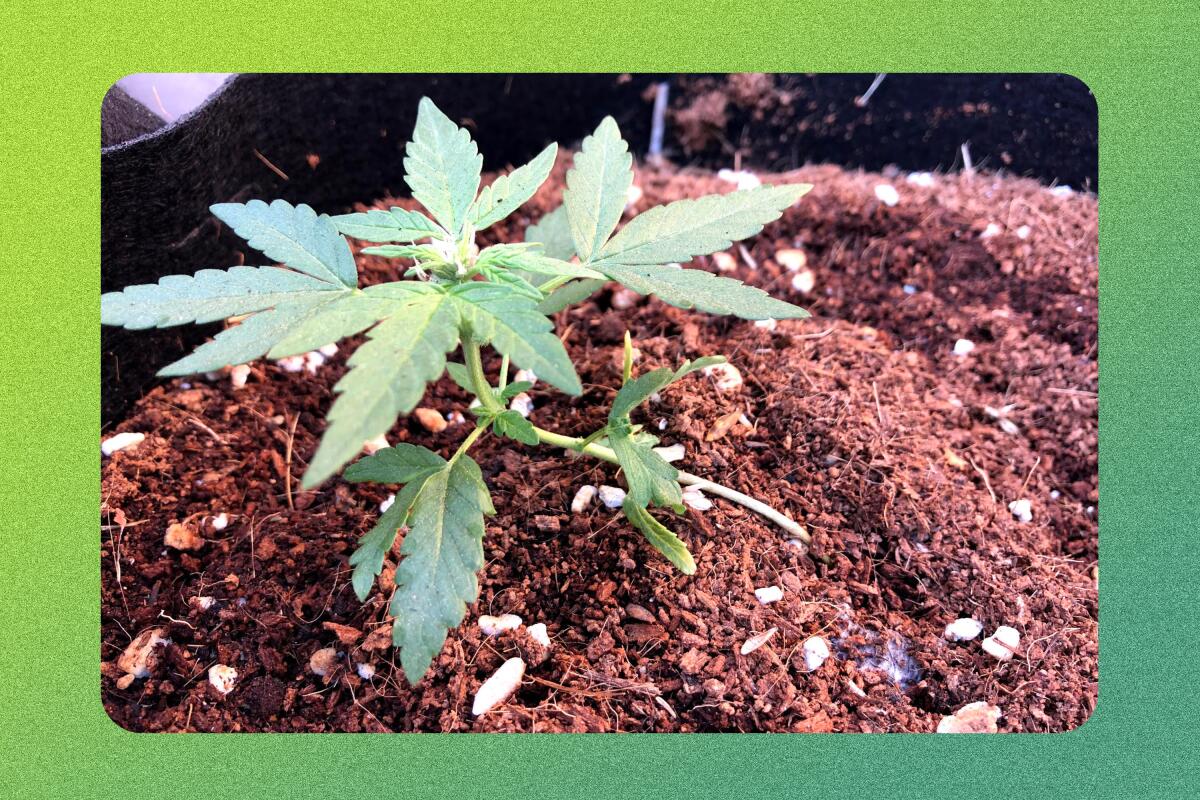
Fast-forward two months and, instead of the towering THC-laced tannenbaum I was hoping for, I was headed into Christmas week with a seedling — all of 5 inches tall — curving out of its pot at a 45-degree angle. Since A Pot for Pot purchases include growing consults via email, I sent off a few photos and a plea for help. A few days later, I heard back from an upbeat consultant named Taylor who wrote: “Thanks for reaching out! What a cute little plant!” Then came the bad news: Based on the photos I’d sent and the timetable I’d described, Mariah wasn’t going to get much bigger. Taylor’s theory was that I had probably waited too long to transplant Mariah from her seedling cup to her 5-gallon fabric pot, unintentionally creating bonsai bud in the process. But the silver lining, as Taylor pointed out, was that because of her stunted size, there would be more than enough nutrients in the soil mix to support a second attempt in that same pot.
So after a few weeks of mourning, I decided to give pot-plant parenting a second try. And this time around, I was determined to spare no expense — potential tax savings be damned. I invested in a bathroom scale so I could weigh the plant between waterings, and when Taylor offhandedly suggested an LED grow light so I could raise my little green girl indoors, I immediately ordered one and cleared a spot in my garage, not far from where my hard-partying friends used to routinely smoke plants like her in the pre-pandemic days.
If you’re wondering why on God’s green earth anyone blessed with the SoCal sunlight would choose to grow a cannabis plant indoors — and shell out money for a light to do it to boot — it’s worth a slight detour here to give you the straight dope on growing your own dope in the state of California (and, by extension, Los Angeles, because the city doesn’t have its own regulations addressing personal cultivation).
Unlike becoming the parent of a human, there’s a minimum age requirement — you have to be 21 — to legally become the parent of a recreational-use pot plant (different regulations apply to medical marijuana). And that six-plant limit? That’s per private residence — not resident — which means you can’t legally grow a dozen plants just because you split the rent with a roommate. Which brings me to another wrinkle that factors heavily into who does and doesn’t get to become a pot-plant parent in this fair city. Although not impossible, it’s far easier if you own the place in which you’re living and growing a pot plant. Even if your landlord doesn’t explicitly forbid the on-premises cultivation of cannabis (which he or she legally can), your lease agreement probably won’t cover the sort of modifications you might make to the property in your pursuit of off-the-grid ganja.
Mother-son pot entrepreneurs? Vape pens that match your track pants? We have questions.
And there’s one last tiny hitch in the homegrown giddyap — and one that’s of particular importance in a city like L.A. where most of us live cheek by jowl: any plants you’re growing must be in a locked space that is not visible to the public.
Taken altogether that means your ability to become a legal pot-plant parent in L.A. — despite what your biological (or botanical) clock is telling you — hinges on who owns your house, how big your yard is and how much money you’re willing to spend on grow kits (like the 5-gallon, $99.95 one I was using), LED lights ($169.95) and feminized cannabis seeds ($89 for five Lowryder Autoflower seeds).
In mid-January, I planted my second seed. When she burst forth from the soil Jan. 19, the split seed casing clinging to the top of the green shoot reminded me of an armored helmet. Having just watched “Wonder Woman 1984,” I impulsively decided this powerful woman would bear the name of the Amazonian superhero’s secret identity: Diana Prince. Eager to avoid my earlier mistake, Diana Prince was transplanted to her forever home just five days later and then locked safely in my garage under the new grow light (20 hours on, 4 hours off). I visited my baby daily, watering her just enough to keep her healthy and thriving.
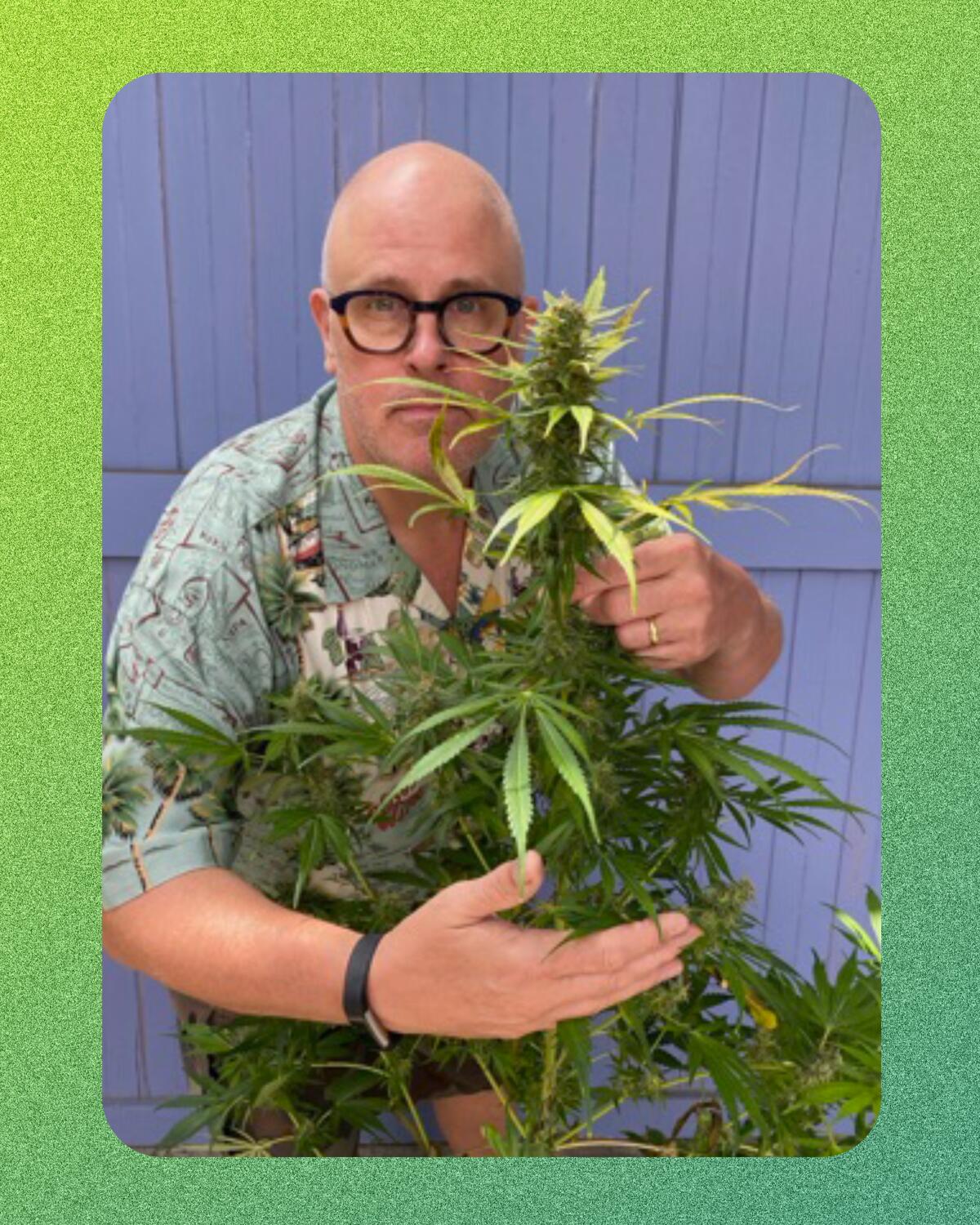
By late March, Diana Prince was stretching skyward and entering her flowering stage. Two months later, she was nearly as tall as me and appeared ready to harvest. Gun-shy from my earlier experience, I sought one last consult. (“Just going off your timeline, she is definitely ready,” replied Taylor — punctuating the sentence with a green emoji heart.)
On May 8, I hacked the branches from the stalk and felt a sharp pang of sadness. After that came a flurry of activities that included drying the branches upside down (using coat hangers, binder clips and a rolling clothes rack), then trimming the buds and finally curing them in an airtight container. (Final yield at this point: 26 grams — just short of an ounce.) According to Taylor’s email, it’s this last part — the curing — that brings out flavor, eliminates the chlorophyll and makes for a smoother smoke. The recommendation was to cure the herb two to eight weeks. Taylor noted that some folks prefer the go-slow approach and will cure their bud for up to six months.
In the run-up to 4/20, a look at some of the ways Southern California is shaping the cannabis conversation.
In early July, the curing phase of Operation Ganja Green Thumb hit Week 8. From the beginning of this botanical adventure, this was the moment I’d been thinking about and waiting for, with visions of sticky bud dancing in my head. Now was the time to literally taste the fruits of my labor, to consume something I’d planted and watched grow to maturity. This was the culmination of my very first seed-to-sesh journey, a chance to bring the lessons of my growing-up years and my enthusiasm for cannabis full circle all at once. The time had finally arrived, and, even without fear of legal retribution, I found myself reticent to pack a pipe or roll a joint and take a taste of my own medicine.
As the eighth week stretched into the ninth, I dutifully burped the curing jar every few days, gazing at the contents with awe before snapping the lid back in place and putting the container away, but I didn’t try it. Was I, on some subconscious level, afraid that I wouldn’t get high enough (or, even worse, not high at all) off my homegrown handiwork? Perhaps the thrill had really been about the process — the pursuit of happiness — the whole time and not about the ounce of weed curing in my pantry. Or maybe I wanted the best for my baby and was dragging my feet only until Diana Prince had cured a full six months?
Then it hit me: In my haste to marry the nostalgic farm-to-table experiences of my Vermont childhood to my love of weed, I’d forgotten the part about not forming an emotional bond and had done exactly that. Even worse, I’d given her a name and imagined a personality for her. By naming her Diana Prince, I’d become less of an urban herb farmer about to get his buzz on and more like the Titan Kronos of Greek mythology about to swallow his offspring.
The fix was easy enough. Brandishing my P-Touch label maker, I printed out “Lowryder strain, seed two” and stuck the label on the container of curing buds, right over top of the one that read “Diana Prince.” I instantly felt better.
More to Read
Sign up for The Wild
We’ll help you find the best places to hike, bike and run, as well as the perfect silent spots for meditation and yoga.
You may occasionally receive promotional content from the Los Angeles Times.

